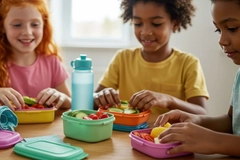Deep Space Food Challenge: NASA selects out of this world food tech tipped to feed astronauts
22 May 2023 --- NASA is looking to solve the challenge of creating reliable solutions to nutritiously and sustainably feed astronauts embarking on longer and more complex space missions. The US agency has completed the second phase of its Deep Space Food Challenge, with the five winning teams working on technologies to prolong the shelf life of food in space. Innovations include mushroom-based ingredients, proteins from “thin-air” and controlled-environment biofarms.
“The possibilities presented in this challenge could help sustain our explorers on future missions and even have the potential to help out right here on Earth in areas where food is scarce or hard to produce,” says Denise Morris, program manager of NASA Centennial Challenges at NASA’s Marshall Space Flight Center in Huntsville, Alabama.
“Astronauts will tell you that tasty and nutritious food is a critical part of any successful human space exploration mission.”
The five winning US teams will join three international projects – selected in collaboration with the Canadian Space Agency – in Phase 3, the final phase of the initiative, competing for US$1.5 million in total prizes.
Winning teams
Phase 2 winners were tasked with building and demonstrating small-scale prototypes of their technologies. They were required to use minimal resources and create little waste while producing safe, healthy and appetizing foods for astronauts.
Air Company, of New York, developed a system and process for turning air, water, electricity and yeast into food. The company currently produces vodka with its technology.
Florida-based Interstellar Lab created a modular bioregenerative system for producing fresh microgreens, vegetables, mushrooms and insects.
 Microgreen food production system developed by Enigma of the Cosmos. (Image Credit: NASA/Methuselah Foundation). Kernel Deltech, the space division of Eternal Bioworks, developed a system for cultivating mushroom-based ingredients. The company’s technology is likened to a “fungi-food version of a coffee pod machine,” being compact, automated and designed for the minimal resources available in space.
Microgreen food production system developed by Enigma of the Cosmos. (Image Credit: NASA/Methuselah Foundation). Kernel Deltech, the space division of Eternal Bioworks, developed a system for cultivating mushroom-based ingredients. The company’s technology is likened to a “fungi-food version of a coffee pod machine,” being compact, automated and designed for the minimal resources available in space.
“With this technology, we are one step closer to making long-duration space travel a reality,” says Lucas Gago, chief innovation officer for Eternal Group.
Nolux, from California, created a solution that mimics photosynthesis to produce plant and mushroom-based ingredients.
SATED (Safe Appliance, Tidy, Efficient, and Delicious) has developed a space cooking appliance to prepare a variety of meals from ingredients with long shelf lives.
“These creative winning solutions come from teams made up of business, universities and individual solvers, showcasing how NASA can benefit from everyone’s expertise to solve crucial challenges,” says Amy Kaminski, program executive for prizes, challenges and crowdsourcing at NASA’s Space Technology Mission Directorate.
“We’re excited to announce Phase 3 of the challenge to see where these teams can take their technologies next,” she notes.
International teams
Furthermore, three teams from outside the US were also selected to advance to the next competition phase.
Enigma of the Cosmos, from Australia, has created an adaptive growing system to increase the efficiency of plants’ natural growth cycles.
Mycorena, from Sweden, has developed a system that combines microalgae and fungi to produce a microprotein.
Meanwhile, Solar Foods has created a system that uses gas fermentation to produce single-cell proteins. In October, Solar Foods got approval from the Singapore Food Agency to sell its alternative protein grown with CO2 and electricity.
While not participating in NASA’s initiative, Israeli cultured meat start-up Aleph Farms previously spearheaded a bold ambition to help accelerate extraterrestrial cell-based protein production.
Its program “Aleph Zero” – backed by food producers such as Cargill, Migros and the Strauss Group – supports deep-space exploration and the potential colonization of new planets.
Food is critical for mission success Edible fungi from Interstellar Lab. (Image Credit: NASA/Methuselah Foundation).
Edible fungi from Interstellar Lab. (Image Credit: NASA/Methuselah Foundation).
Currently, the shelf life of space foods ranges from nine months to five years. While the longest-lasting foods could, on paper, cover a mission to Mars, better foods are needed.
“Space food quality and nutrition degrade to unacceptable levels in two to three years with current food stabilization technologies. Future exploration missions will require a food system that remains safe, acceptable and nutritious through five years of storage within vehicle resource constraints,” explains a NASA technical report.
Space to Earth nutrition
Researchers are experimenting with new ways to grow and prepare food in space. Their research is being used to develop new food technologies that can be used to improve food production and security on Earth.
Scientists sent crop seeds to space earlier this year to submit them to a round of analyses. The experiment will help understand whether cosmic radiation and space conditions have a uniquely beneficial effect on crop improvement and could benefit people on Earth.
In partnership with the University of Maryland in the US and the University of Strasbourg in France, NASA Harvest and Planet Labs have been using satellite imaging to analyze Ukrainian crops from above, tracking their day-to-day changes. NASA shares the collected data and analysis with other countries looking for help in rapidly assessing dynamic crop changes, potentially anticipating food chain disruption, shortages and famines.
In other developments, microgreens packed with antioxidants have gained popularity as a functional food that could help contribute to a balanced diet for astronauts. A US study recently revealed how these tiny but mighty plants could unlock nutrition challenges in long-term space missions.
By Marc Cervera













